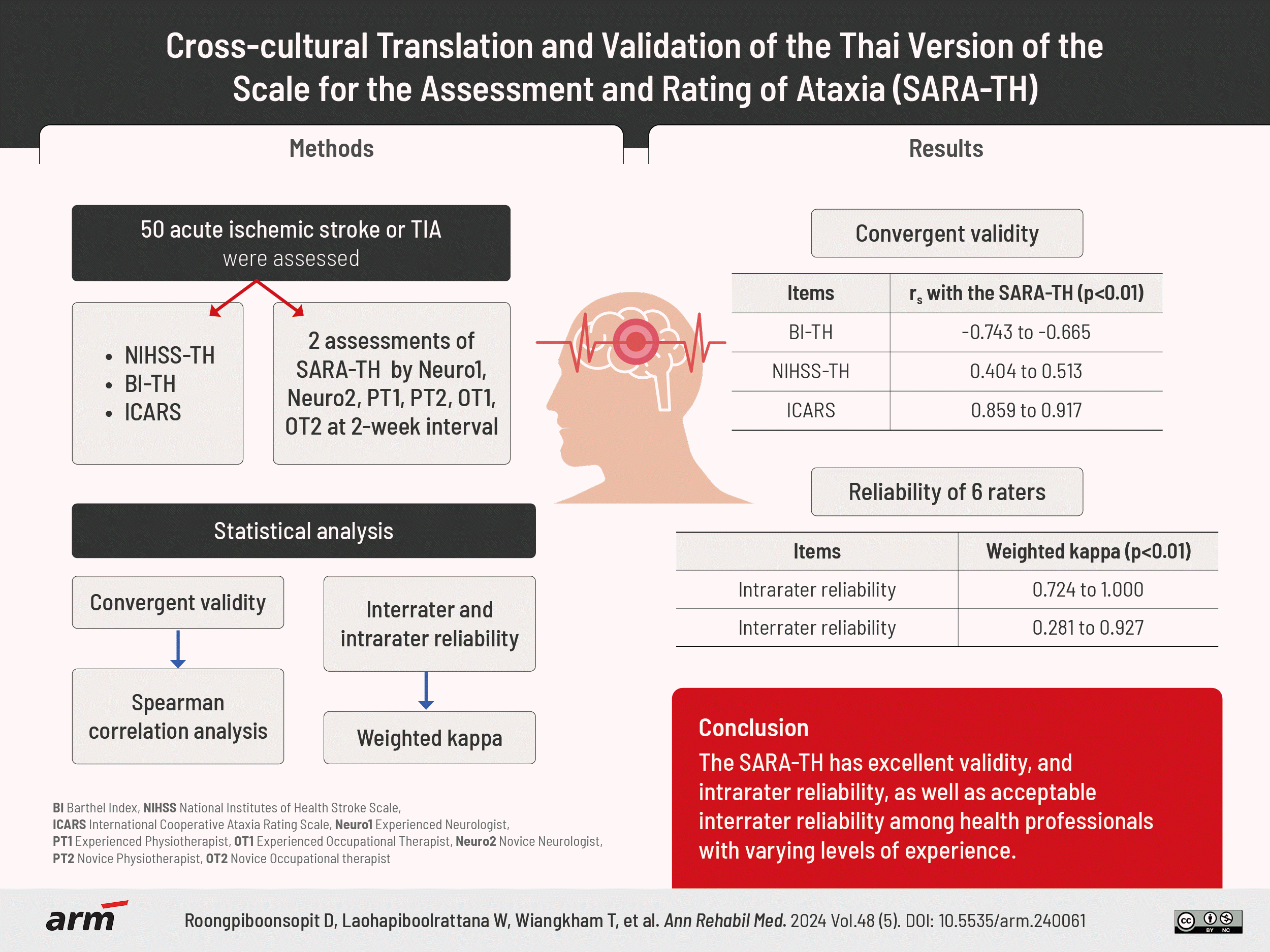1. Mariotti C, Fancellu R, Di Donato S. An overview of the patient with ataxia. J Neurol. 2005; 252:511–8.

2. Ashizawa T, Xia G. Ataxia. Continuum (Minneap Minn). 2016; 22(4 Movement Disorders):1208–26.

4. Stanley WJ, Kelly CKL, Tung CC, Lok TW, Ringo TMK, Ho YK, et al. Cost of cerebellar ataxia in Hong Kong: a retrospective cost-of-illness analysis. Front Neurol. 2020; 11:711.

5. Schmitz-Hübsch T, Tezenas du Montcel S, Baliko L, Boesch S, Bonato S, Fancellu R, et al. Reliability and validity of the International Cooperative Ataxia Rating Scale: a study in 156 spinocerebellar ataxia patients. Mov Disord. 2006; 21:699–704.

6. Schmitz-Hübsch T, du Montcel ST, Baliko L, Berciano J, Boesch S, Depondt C, et al. Scale for the assessment and rating of ataxia: development of a new clinical scale. Neurology. 2006; 66:1717–20.
7. Weyer A, Abele M, Schmitz-Hübsch T, Schoch B, Frings M, Timmann D, et al. Reliability and validity of the scale for the assessment and rating of ataxia: a study in 64 ataxia patients. Mov Disord. 2007; 22:1633–7.

8. Braga-Neto P, Godeiro-Junior C, Dutra LA, Pedroso JL, Barsottini OG. Translation and validation into Brazilian version of the Scale of the Assessment and Rating of Ataxia (SARA). Arq Neuropsiquiatr. 2010; 68:228–30.

9. Sato K, Yabe I, Soma H, Yasui K, Ito M, Shimohata T, et al. [Reliability of the Japanese version of the Scale for the Assessment and Rating of Ataxia (SARA)]. Brain Nerve. 2009; 61:591–5. Japanese.
10. Tan S, Niu HX, Zhao L, Gao Y, Lu JM, Shi CH, et al. Reliability and validity of the Chinese version of the Scale for Assessment and Rating of Ataxia. Chin Med J (Engl). 2013; 126:2045–8.

11. Kim BR, Lee JY, Kim MJ, Jung H, Lee J. Korean version of the scale for the assessment and rating of ataxia in ataxic stroke patients. Ann Rehabil Med. 2014; 38:742–51.

12. Bourcier D, Bélair N, Pedneault-Tremblay ÉA, Lessard I, Klockgether T, Synofzik M, et al. French translation and cross-cultural adaptation of the Scale for the Assessment and Rating of Ataxia. Cerebellum. 2023; 22:1118–22.

13. Beaton DE, Bombardier C, Guillemin F, Ferraz MB. Guidelines for the process of cross-cultural adaptation of self-report measures. Spine (Phila Pa 1976). 2000; 25:3186–91.

15. Easton JD, Saver JL, Albers GW, Alberts MJ, Chaturvedi S, Feldmann E, American Heart Association; American Stroke Association Stroke Council; Council on Cardiovascular Surgery and Anesthesia; Council on Cardiovascular Radiology and Intervention; Council on Cardiovascular Nursing; Interdisciplinary Council on Peripheral Vascular Disease, et al. Definition and evaluation of transient ischemic attack: a scientific statement for healthcare professionals from the American Heart Association/American Stroke Association Stroke Council; Council on Cardiovascular Surgery and Anesthesia; Council on Cardiovascular Radiology and Intervention; Council on Cardiovascular Nursing; and the Interdisciplinary Council on Peripheral Vascular Disease. The American Academy of Neurology affirms the value of this statement as an educational tool for neurologists. Stroke. 2009; 40:2276–93.

16. Folstein MF, Folstein SE, McHugh PR. “Mini-mental state”. A practical method for grading the cognitive state of patients for the clinician. J Psychiatr Res. 1975; 12:189–98.
17. Green J, Forster A, Young J. A test-retest reliability study of the Barthel Index, the Rivermead Mobility Index, the Nottingham Extended Activities of Daily Living Scale and the Frenchay Activities Index in stroke patients. Disabil Rehabil. 2001; 23:670–6.

18. Duffy L, Gajree S, Langhorne P, Stott DJ, Quinn TJ. Reliability (inter-rater agreement) of the Barthel Index for assessment of stroke survivors: systematic review and meta-analysis. Stroke. 2013; 44:462–8.

19. Dajpratham P, Meenaphant R, Junthon P, Pianmanakij S, Jantharakasamjit S, Yuwan A. The inter-rater reliability of Barthel Index (Thai version) in stroke patients. J Thai Rehabil. 2006; 16:1–9.
20. Brott T, Adams HP Jr, Olinger CP, Marler JR, Barsan WG, Biller J, et al. Measurements of acute cerebral infarction: a clinical examination scale. Stroke. 1989; 20:864–70.

21. Farooque U, Lohano AK, Kumar A, Karimi S, Yasmin F, Bollampally VC, et al. Validity of National Institutes of Health Stroke Scale for severity of stroke to predict mortality among patients presenting with symptoms of stroke. Cureus. 2020; 12:e10255.

22. Nilanont Y, Phattharayuttawat S, Chiewit P, Chotikanuchit S, Limsriwilai J, Chalernpong L, et al. Establishment of the Thai version of National Institute of Health Stroke Scale (NIHSS) and a validation study. J Med Assoc Thai. 2010; 93 Suppl 1:S171–8.
23. Subramony SH. SARA--a new clinical scale for the assessment and rating of ataxia. Nat Clin Pract Neurol. 2007; 3:136–7.

24. Saute JA, Donis KC, Serrano-Munuera C, Genis D, Ramirez LT, Mazzetti P, Iberoamerican Multidisciplinary Network for the Study of Movement Disorders (RIBERMOV) Study Group, et al. Ataxia rating scales--psychometric profiles, natural history and their application in clinical trials. Cerebellum. 2012; 11:488–504.

25. McHorney CA, Tarlov AR. Individual-patient monitoring in clinical practice: are available health status surveys adequate? Qual Life Res. 1995; 4:293–307.

26. Sedgwick P. Spearman’s rank correlation coefficient. BMJ. 2014; 349:g7327.

27. Akoglu H. User’s guide to correlation coefficients. Turk J Emerg Med. 2018; 18:91–3.

28. Taber KS. The use of Cronbach’s alpha when developing and reporting research instruments in science education. Res Sci Educ. 2018; 48:1273–96.

29. McHugh ML. Interrater reliability: the kappa statistic. Biochem Med (Zagreb). 2012; 22:276–82.

30. Rummey C, Harding IH, Delatycki MB, Tai G, Rezende T, Corben LA. Harmonizing results of ataxia rating scales: mFARS, SARA, and ICARS. Ann Clin Transl Neurol. 2022; 9:2041–6.

32. Tavakol M, Dennick R. Making sense of Cronbach’s alpha. Int J Med Educ. 2011; 2:53–5.

33. Chien CW, Scanlon C, Rodger S, Copley J. Intra- and Inter-rater reliability of the assessment of children’s hand skills based on video recordings. Br J Occup Ther. 2014; 77:82–90.

34. Grobe-Einsler M, Amin AT, Faber J, Völkel H, Synofzik M, Klockgether T. Scale for the Assessment and Rating of Ataxia (SARA): development of a training tool and certification program. Cerebellum. 2024; 23:877–80.





 PDF
PDF Citation
Citation Print
Print




 XML Download
XML Download